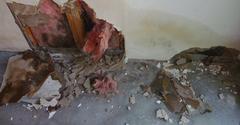
When Plano homeowners find themselves with water damage in Plano TX, often they attempt to remove the water themselves to save some money. However, moisture can be tricky to get rid of. You may not actually be as dry as you think. A couple of types of materials in the home are notorious for hiding moisture, and letting water remain can end up costing thousands of dollars in escalating damage later on. Water damage repair in Plano TX goes beyond a towel and a mop.
Concrete Floors & Walls
Our basements and crawlspaces in Plano are generally made of concrete. Even if initially sealed by the builder, overtime, the sealant can break down. Moisture from under the slabs or behind the walls can seep through the concrete material and create water damage issues and a mildew-y, musty odor in Plano TX. If the paint on your concrete floor or wall begins to bubble or shift, that means the sealing product underneath the paint has failed and water is penetrating your home. Consider having spaces such as those periodically examined by a basement waterproofing company to see if there are any steps that need to be taken to eliminate water coming in through the walls and floor and also to prevent it in the first place.
Drywall & Insulation
When drywall or sheetrock is damaged by water, it sometimes needs to be replaced, depending on how it was constructed and how long the wall was left water-logged. Most drywall has a permeable paper backing on each side, and standard latex paint will allow moisture through. Drywall itself, then, if it doesn’t stay wet for too long, can often be dried because air, just like the water, can pass all the way through to help the moisture evaporate.
If there was insulation behind it, there may be another story. If the water soaked into your insulation behind the drywall, you may have to remove the drywall in order to examine the insulation. If it was made of fiberglass batt, it can sometimes dry more quickly because they don’t soak up water. The downside is that fiberglass insulation is usually a great host for dust particles, and those do absorb water and can house mold spores. Because this type of insulation is relatively inexpensive and it may take a long, labor-intensive process to dry the materials, many homeowners opt to just remove and replace with new insulation.
Blown-in cellulose insulation is made of organic materials that act like sponges when in contact with water. Because they become so water-laden, it takes much longer for this type of insulation to dry. And the longer the damp insulation remains in contact with the surrounding wooden structures, the more likely you’ll end up with structural damage and mold growth. This type of insulation can’t be salvaged.
Professional Water Damage Restoration in Plano, TX
Your local, certified water damage restoration specialist in Plano, TX, will be able to determine the correct course of action for remediation based on your unique environment and materials. Restoration XP doesn’t offer “cookie cutter” services. They tailor their plan of action for water damage repair in Plano TX to each customer’s needs and have the experience and expertise to get you back to dry.